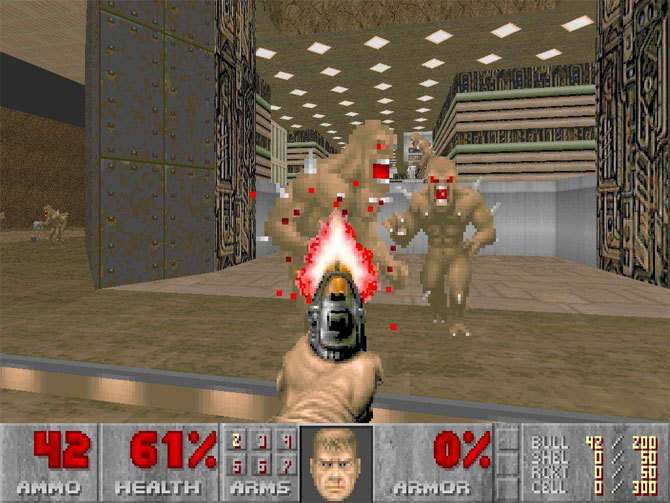The most realistic animation
Digital future, virtual reality, animation of objects, so high-quality that it will not be confused with reality for long.
Until recently, all this seemed impossible. We sat at home and cut into primitive computer games with no less primitive computer graphics, such as Mario, Doom, Dune, and Lemmings. Yes, yes, my young friend! There were such games in the 90s, where the background was poorly drawn, and the resolution of the picture was so low that all the characters and the poorly drawn background, including, were broken, to put it mildly, into pixels easily visible to the human eye.

Game Doom (1993)
But every day progress is moving forward, and computer graphics are following it.
The last animated creation is called Ed. And the difference between what we remember and what we have now, so to speak, on the face.
These parts of the body, shown on video, are the work of the ingenious Australian designer Chris Jones. In principle, no new technologies were invented by the designer. He simply took advantage of the traditional CGI technology used to create three-dimensional computer graphics, as well as used in the visual arts, printing, cinematic special effects and computer games.
Chris began the process of creating Ed about 10 years ago. He used programs such as Sculptris, Lightwave, and Blender to create sculptures, simulations, and objects.
Despite the fact that it was supposed to be a regular test project, the designer went into it with his head and decided to play with the texture. Here is what came of it:
The next steps were the creation of wrinkles and eyes.
After a series of breaks and creative searches, Chris got back to work and made some progress on this guy. He supplemented his animation with one of the three tracks that he himself wrote in 2004.
This was followed by the process of applying textures and colors to Ed's eyeball.
Beyond the eye, Chris introduced another body part from his ever-expanding collection.
Now that all the components of Ed’s head have been put together, all that remains is to apply color. And so the process of creating a human head went on. In general, it turned out pretty well if you did not find fault with the fact that there is no mimic trembling of muscles and their spontaneous micromotion, than such a computer animation has been suffering for decades. At this pace, it will soon be possible to replace an unexpectedly ill actor in a new blockbuster or to generate a new, so to speak, ideal. Here are the directors where to turn around!

Until recently, all this seemed impossible. We sat at home and cut into primitive computer games with no less primitive computer graphics, such as Mario, Doom, Dune, and Lemmings. Yes, yes, my young friend! There were such games in the 90s, where the background was poorly drawn, and the resolution of the picture was so low that all the characters and the poorly drawn background, including, were broken, to put it mildly, into pixels easily visible to the human eye.

Game Doom (1993)
But every day progress is moving forward, and computer graphics are following it.
The last animated creation is called Ed. And the difference between what we remember and what we have now, so to speak, on the face.
These parts of the body, shown on video, are the work of the ingenious Australian designer Chris Jones. In principle, no new technologies were invented by the designer. He simply took advantage of the traditional CGI technology used to create three-dimensional computer graphics, as well as used in the visual arts, printing, cinematic special effects and computer games.
Chris began the process of creating Ed about 10 years ago. He used programs such as Sculptris, Lightwave, and Blender to create sculptures, simulations, and objects.
Despite the fact that it was supposed to be a regular test project, the designer went into it with his head and decided to play with the texture. Here is what came of it:
The next steps were the creation of wrinkles and eyes.
After a series of breaks and creative searches, Chris got back to work and made some progress on this guy. He supplemented his animation with one of the three tracks that he himself wrote in 2004.
This was followed by the process of applying textures and colors to Ed's eyeball.
Beyond the eye, Chris introduced another body part from his ever-expanding collection.
Now that all the components of Ed’s head have been put together, all that remains is to apply color. And so the process of creating a human head went on. In general, it turned out pretty well if you did not find fault with the fact that there is no mimic trembling of muscles and their spontaneous micromotion, than such a computer animation has been suffering for decades. At this pace, it will soon be possible to replace an unexpectedly ill actor in a new blockbuster or to generate a new, so to speak, ideal. Here are the directors where to turn around!

